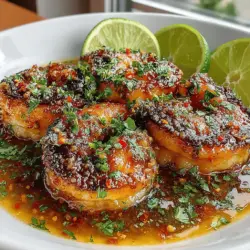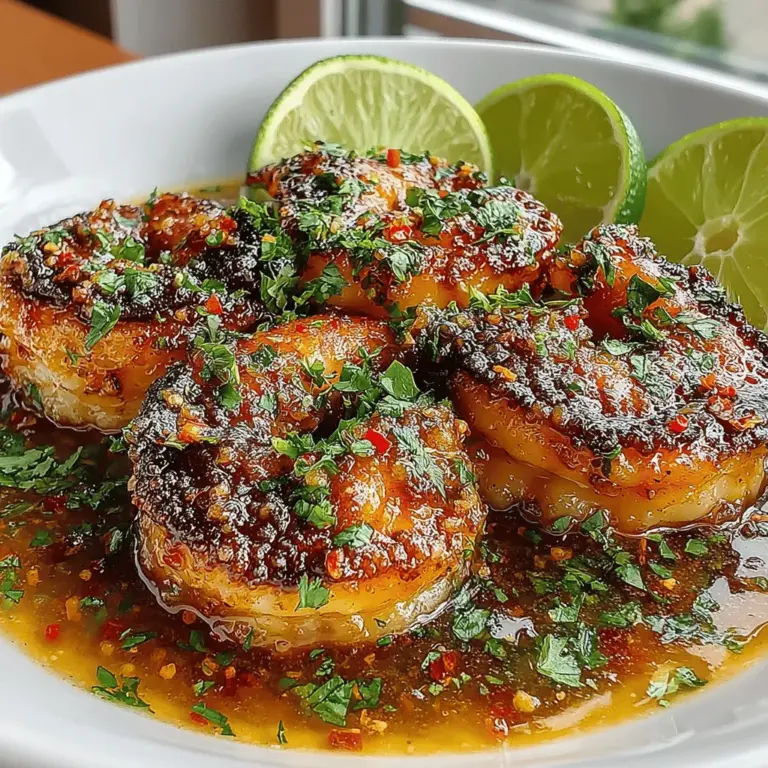Mango Glazed Shrimp Recipe
Introduction
Mango Glazed Shrimp is a vibrant and flavorful seafood dish that brings together the sweet and tangy notes of ripe mango with succulent shrimp. This recipe is not only a treat for the taste buds but also a feast for the eyes, showcasing a beautiful blend of colors that can brighten up any dinner table. The combination of juicy mango and tender shrimp makes for a delightful pairing that is both refreshing and satisfying.
One of the standout features of this dish is its ease of preparation. With a quick cook time and simple ingredients, Mango Glazed Shrimp is perfect for busy weeknight dinners or even special occasions when you want to impress guests without spending hours in the kitchen. In just a matter of minutes, you can whip up a meal that tastes as if it has come straight from a gourmet restaurant, allowing you to enjoy a restaurant-quality dish in the comfort of your own home.
Understanding the Ingredients
To create the best Mango Glazed Shrimp, it’s essential to understand the key ingredients that make this dish shine. Each component not only contributes to the flavor profile but also offers a range of health benefits.
Shrimp
Shrimp serves as the star of this recipe. Not only is it delicious, but it is also packed with nutrients. Rich in protein, low in calories, and a good source of omega-3 fatty acids, shrimp is an excellent choice for a health-conscious meal. When selecting shrimp for this recipe, you can choose between fresh or frozen, raw or cooked varieties. For the best results, opt for large, raw shrimp with the shells on. If using frozen shrimp, ensure they are thawed properly before cooking.
Mango
Mango adds a tropical flair to the dish, providing a luscious sweetness that balances the savory notes of the shrimp. This fruit is a powerhouse of vitamins and minerals, particularly vitamin C, which supports the immune system. When selecting a ripe mango, look for one that yields slightly to gentle pressure and has a sweet aroma. The color can vary depending on the variety, but a vibrant yellow or orange hue typically indicates ripeness.
Honey
Honey plays a crucial role in the glaze, providing natural sweetness and a beautiful glaze that caramelizes during cooking. It is also known for its antioxidant properties and potential health benefits, such as soothing sore throats and boosting energy levels. When choosing honey for this recipe, consider using raw or local honey for added flavor complexity.
Soy Sauce and Lime Juice
Soy sauce acts as a savory enhancer, introducing umami flavors that complement both the shrimp and mango. Lime juice adds a zesty brightness, elevating the dish’s overall flavor profile. Together, they create a balanced taste that is both sweet and savory, making each bite a delightful experience.
Garlic and Ginger
The aromatic qualities of garlic and ginger add depth to the glaze, infusing the shrimp with warm, spicy undertones. Both ingredients come with their own set of health benefits; garlic is known for its anti-inflammatory properties, while ginger can aid digestion and reduce nausea. Their combination in the glaze not only enhances the flavor but also contributes to a healthier meal.
Optional Ingredients
For those who appreciate a bit of heat, red pepper flakes can be added to the glaze to spice things up. This optional ingredient allows you to customize the dish to your preferred heat level. Additionally, fresh cilantro can be used as a garnish, providing a pop of color and a fresh herbal note that perfectly complements the sweetness of the mango.
Step-by-Step Guide to Preparing Mango Glazed Shrimp
Preparing the Mango Glaze
The first step in making Mango Glazed Shrimp is preparing the mango glaze. Begin by gathering all your ingredients: ripe mango, honey, soy sauce, lime juice, garlic, and ginger. To create a smooth glaze, peel and chop the mango into small pieces, then place it in a blender or food processor. Add in the honey, soy sauce, lime juice, minced garlic, and grated ginger. Blend the mixture until it reaches a smooth consistency, ensuring that all ingredients are well integrated. This glaze will be the key flavor component of your dish.
It’s important to set aside half of the glaze before marinating the shrimp. This reserved portion will be used to finish the dish later, ensuring that the shrimp is coated in fresh glaze just before serving. By doing this, you maintain the vibrant flavor of the mango and prevent it from losing its freshness during cooking.
Marinating the Shrimp
Once your glaze is ready, it’s time to marinate the shrimp. Place the cleaned and deveined shrimp in a bowl, and pour half of the mango glaze over them. Ensure that each shrimp is well coated by gently tossing them in the marinade. Marinating is an essential step that allows the shrimp to absorb the flavors of the glaze, enhancing the overall taste of the dish. For optimal flavor absorption, let the shrimp marinate for at least 15 to 30 minutes in the refrigerator. This brief marinating time is sufficient to infuse the shrimp with the sweet and savory notes of the mango glaze while keeping the shrimp tender and juicy.
As you prepare to cook the shrimp, remember that the secret to achieving that perfect glaze lies in the timing and heat. After the marination period, you will be ready to move on to the cooking process, which will transform these marinated shrimp into a mouthwatering dish that is sure to impress.
{{image_2}}
Cooking the Shrimp
Cooking shrimp to perfection requires a keen eye and precise timing. Once your shrimp are marinated and ready to go, heat your skillet over medium-high heat. This temperature is crucial as it allows the shrimp to cook quickly without becoming rubbery.
Techniques for Achieving the Perfect Shrimp Texture
As the shrimp cook, watch for the color changes that signal doneness. Raw shrimp are a grayish color, but as they cook, they transition to a lovely pink hue. The shrimp will also start to curl into a C-shape when they are nearing completion. Typically, shrimp only need about 2 to 3 minutes per side to cook thoroughly, depending on their size.
Avoiding Overcrowding: One of the most common mistakes when cooking shrimp is overcrowding the pan. If too many shrimp are added at once, they will steam rather than sear, resulting in a less desirable texture. To maintain optimal cooking conditions, consider cooking your shrimp in batches. This ensures each piece gets the chance to develop a nice golden sear and retains its juiciness.
Finishing Touches with the Glaze
Once your shrimp are perfectly cooked, it’s time to introduce the mango glaze. This is where the magic happens. The glaze not only adds a glossy finish but also enhances the flavor profile of the shrimp.
Steps to Thicken the Glaze
If you have a thin glaze, you can thicken it by simmering it on medium-low heat for a few minutes. This allows the sugars in the mango and honey to caramelize slightly, creating a richer flavor. Stir the glaze occasionally to prevent it from sticking to the pan. Once it reaches a syrupy consistency, add the cooked shrimp back into the pan and toss them gently in the glaze to coat thoroughly.
How the Glaze Complements the Shrimp
The combination of sweet mango, savory garlic, and a hint of ginger creates a perfect balance that elevates the shrimp. The luscious glaze clings to the shrimp, infusing each bite with tropical flavor while the bright acidity from lime juice cuts through the richness, making it an irresistible dish.
Presentation and Serving Suggestions
Now that your mango glazed shrimp are ready to serve, presentation becomes vital to impress your guests or family.
Tips for Plating the Dish Attractively
1. Choose the Right Plate: Opt for a white or light-colored plate to make the vibrant colors of the shrimp and glaze pop.
2. Layer Your Ingredients: Start with a bed of cooked jasmine or coconut rice, then arrange the shrimp on top, drizzling the glaze over the dish.
3. Garnish Thoughtfully: Fresh herbs like cilantro or basil add a splash of color and freshness. You can also sprinkle sesame seeds or chopped green onions for added texture.
Side Dishes that Pair Well
For a complete meal, consider serving your mango glazed shrimp with one or more of the following side dishes:
– Coconut Rice: The creamy texture of coconut rice complements the tropical flavors of the shrimp.
– Mixed Green Salad: A refreshing salad with a light vinaigrette balances the richness of the dish.
– Grilled Vegetables: Vegetables such as zucchini, bell peppers, or asparagus add color and nutrition.
Nutritional Information and Health Benefits
When enjoying mango glazed shrimp, you can feel good about the nutritional benefits it brings.
Nutritional Profile
A typical serving of mango glazed shrimp (approximately 4 ounces) provides:
– Calories: 250
– Protein: 25g
– Fat: 10g
– Carbohydrates: 12g
– Fiber: 1g
Benefits of Seafood in a Balanced Diet
Seafood, particularly shrimp, is an excellent source of lean protein and essential omega-3 fatty acids. These nutrients support heart health, brain function, and muscle development. Regular consumption of seafood can also lower the risk of chronic diseases and improve overall health.
Antioxidant Properties of Mango and Benefits of Garlic and Ginger
Mango is not only delicious but also packed with antioxidants, vitamins A and C, which support the immune system and promote healthy skin. Garlic has well-documented health benefits, including anti-inflammatory and immune-boosting properties. Ginger adds flavor and can aid in digestion and reduce nausea, making this dish not only tasty but also beneficial for your health.
Culinary Variations and Adaptations
While the mango glazed shrimp recipe is delightful as is, there are several ways to adapt it to suit different dietary preferences.
Modifying the Recipe
1. Vegetarian or Vegan Options: Substitute shrimp with tofu or tempeh. Marinate them similarly and follow the same cooking process to achieve a delicious plant-based version.
2. Gluten-Free Options: Ensure that the soy sauce or any other condiments used in the glaze are gluten-free. Tamari is an excellent substitute for traditional soy sauce.
Exploring Different Types of Seafood
If shrimp isn’t your first choice, consider using scallops, prawns, or even fish fillets like salmon or tilapia. Each option will bring a unique texture and flavor, enhancing the versatility of the dish.
Incorporating Additional Vegetables or Sides
You can also enhance the dish by adding vegetables directly to the glaze. Bell peppers, snap peas, or baby corn can be sautéed alongside the shrimp, creating a colorful medley that boosts the meal’s nutritional value.
Conclusion
In conclusion, mango glazed shrimp is a delightful dish that combines sweet, savory, and tropical flavors, making it a lovely addition to any meal rotation. The ease of preparation and the quick cooking time make it an ideal choice for busy weeknights or special occasions alike.
This recipe not only highlights the natural sweetness of mango but also showcases the tender juiciness of perfectly cooked shrimp, resulting in a dish that is both nutritious and satisfying.
We encourage you to try this recipe and experience the delightful combination of flavors for yourself. The versatility of this dish allows it to be tailored to various dietary preferences, ensuring it can become a family favorite for years to come. Enjoy the burst of tropical flavor and the health benefits that accompany each bite!


